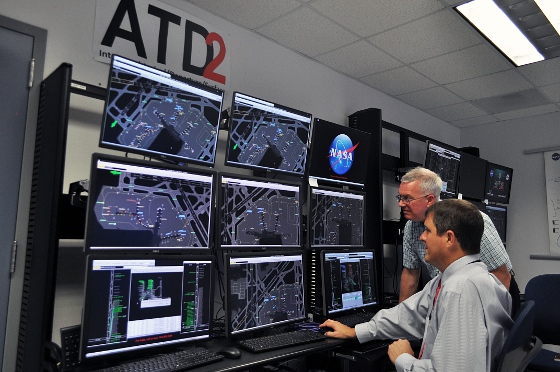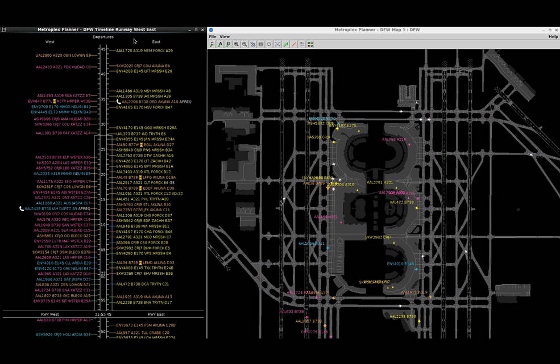 |
| December 28, 2021 | Volume 17 Issue 48 |
Designfax weekly eMagazine
Archives
Partners
Manufacturing Center
Product Spotlight
Modern Applications News
Metalworking Ideas For
Today's Job Shops
Tooling and Production
Strategies for large
metalworking plants
NASA air traffic management tech rolling out to airports

At NASA's air traffic management laboratory near the Dallas/Ft. Worth International Airport in Texas, researchers Al Capps (seated) and Paul Borchers demonstrate Airspace Technology Demonstration 2 (ATD-2) tools that air traffic managers began testing in 2017. [Credits: NASA/Jim Banke]
NASA Administrator Bill Nelson visited Orlando International Airport in Florida on Nov. 24 and met with aviation leaders to discuss implementing aircraft flight scheduling technology developed by the agency that will soon improve dependability for passengers -- which is especially important during peak travel times like holidays.
In September, the technology that was tested during NASA's Airspace Technology Demonstration 2 (ATD-2) was transferred to the Federal Aviation Administration (FAA). Large airports across the country, including Orlando International, will soon implement the technology. Nelson discussed the technology transfer with Greater Orlando Aviation Authority CEO Phil Brown.
"Our flight scheduling technology, which makes it possible for personnel to better coordinate the movements of aircraft while they're at the airport, will soon help ensure more passengers get off the ground and home for the holidays faster and more efficiently than ever before," Nelson said.
NASA and the FAA completed nearly four years of surface operations research and testing to calculate gate pushbacks through time-based metering at busy hub airports, so that planes can roll directly to the runway to take off and avoid excessive taxi and hold times, reducing fuel use, emissions, and passenger delays. The FAA plans to deploy NASA's surface metering technology initially to 27 airports as part of a larger investment in airport surface management technology called the Terminal Flight Data Manager (TFDM) program.
"The anticipated rollout of the updated TFDM in 2023 aligns with our projections for returning to pre-pandemic passenger traffic the same year," Brown said. "These updates should result in a smoother experience for the traveling public and enhance 'The Orlando Experience' we strive to offer every day at our world-class airport."

The test subject of ATD-2 is "Integrated Arrivals Departures Scheduling," a software tool that coordinates schedules between the ramp, tower, terminal, and center control facilities, allowing air traffic controllers to better predict where and when to send aircraft in order to reduce congestion. [Credits: NASA]
NASA's ATD-2 team first put their aircraft scheduling technology to the test with real-world users in September 2017 at Charlotte-Douglas International Airport. By September 2021, the integrated arrival and departure system (IADS) tools had saved more than 1 million gallons of jet fuel.
By minimizing taxi delay and ramp congestion, ATD-2 demonstrated a reduction in fuel burn and carbon dioxide emissions and supports the administration's goal to build a sustainable aviation system. During testing at Charlotte Douglas International Airport, the program reduced taxi times, helping save more than 275,000 gallons of fuel annually -- enough to fly 185 Boeing 737 aircraft between New York and Chicago. The program also reduced greenhouse gas emissions by 8 tons of carbon dioxide daily and reduced delays by 916 hours over four years, equivalent to an average of 15 minutes of wait time on a taxiway for more than 3,600 departing flights. Those savings were made possible by reducing jet engine run time, which also decreases maintenance costs and saved airlines an estimated nearly $1.4 million in flight crew costs. Overall, passengers were spared 933 hours in flight delays and saved an estimated $4.5 million in value of time.
NASA has released a video highlighting the successful tests at Charlotte Douglas International Airport.
"As we deploy this software, the travel experience gets better for passengers, all the while aviation's emissions decrease. It's a win-win," said FAA Administrator Stephen Dickson. "The future of flight must be more sustainable and environmentally friendly. This new capability as part of a flight merging system has a double benefit: It reduces aircraft emissions while, at the same time, air travelers experience more on-time departures."
Source: NASA
Published December 2021
Rate this article
View our terms of use and privacy policy
